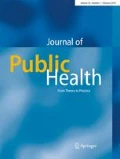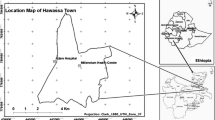Abstract
Aims
The aim of this study was to determine the prevalence of the diagnosed gastrointestinal parasites among hospitalized children attending the Al-Nasser Paediatric Hospital.
Method
This was a cross-sectional study among hospitalized children attending the Al-Nasser Paediatric Hospital. The study included 522 children during the period May 2002 to May 2003. Data collection included two methods: medical laboratory results for the examination of stool specimens and a questionnaire. Wet mount using saline and Lugol’s iodine and formal ether sedimentation techniques were employed in the present study.
Results
Evidence for infection with the gastrointestinal parasites was found in 176 (33.7%) of the children. The intestinal parasites were most prevalent in females (38.8%). The most highly prevalent parasite was found to be Entamoeba histolytica/dispar (26.4%) and the monthly high prevalence of intestinal parasites was in February (54.5%). The prevalence of intestinal parasites increased significantly with increasing age for both Giardia lamblia and E. histolytica/dispar.
Conclusions
The study showed a high prevalence of E. histolytica/dispar infection among hospitalized children. Hygiene and health measures should be reviewed in the hospital where nosocomial infection cannot be excluded. The diagnostic techniques for stool specimens should be reviewed and improved. Physicians in hospitals and private clinics should be aware of intestinal parasitic diseases when requesting stool specimens and prescribing drugs.


Similar content being viewed by others
References
Abed YA (1979) An epidemiological study of the prevalence of parasites and their effect on HB and growth and development in children in Jabalia village. M.Sc. Dissertation, Hadassah Medical School, Jerusalem, p 94
Abu Mourad TA (2004) Palestinian refugee conditions associated with intestinal parasites and diarrhoea: Nuseirat refugee camp as a case study. Public Health 118:131–142
Al-Agha R, Teodorescu I (2000) Intestinal parasites infestation and anemia in primary school children in Gaza Governorates–Palestine. Roum Arch Microbiol Immunol 59(1–2):131–143
Al-Hindi AI (2002) Prevalence of some intestinal parasites among school children in Deir-El-Balah Town, Gaza Strip, Palestine. Ann Saudi Med 22:3–4
Al-Hindi AI, El-Kichaoi A (2008) Occurrence of gastrointestinal parasites among pre-school children, Gaza, Palestine. J Islamic Univ of Gaza 16(1)
Al-Wahaidi A (1997) Effect of different sanitation conditions on the prevalence of infection with three types of intestinal parasites among children in two localities in the Gaza Strip, Palestine. Dissertation submitted as part of the requirements for the degree of Master of Science in mother and child health, University College, London
Al-Hindi A, Shubair ME, Marshall I, Ashford RW, Sharif FA, Abed AA, Kamel EG (2005) Entamoeba histolytica or Entamoeba dispar among children in Gaza, Gaza Strip? J Egypt Soc Parasitol 35:59–68
Al-Nasser Hospital Archive 2002
Ali-Shtayeh MS, Hamdan AH, Shaheen SF, Abu-Zeid I, Faidy YR (1989) Prevalence and seasonal fluctuations of intestinal parasitic infections in the Nablus area, West Bank of Jordan. Ann Trop Med Parasitol 83(1):67–72
Cheesbrough M (1987) Medical laboratory manual for tropical countries, vol 1, 2nd edn. Butterworth-Heinemann, Cambridge
Safi J, Soliman H, El-Nahal YZ (2000) Surveillance of school children prevalence of infectious parasites in Beach camp at Gaza, Palestine. J Pest Control Environ Sci 8(2):123–134
Sharif FA (2002) Prevalence and seasonal fluctuations of common intestinal parasites in Khan Younis, 1996–2000. J Islamic Univ Gaza 10(2):69–79
Shubair M, Yassin MM, Al-Hindi AI, Al-Wahaidiv AA, Jadallah SY, Abu Shaaban ND (2000) Intestinal parasites in relation to haemoglobin level and nutritional status of school children in Gaza. J Egypt Soc Parasitol 30(2):365–375
Smith CMC (1993) The effect of the introduction of piped sewerage on Ascaris infection and environmental contamination in a Gaza Strip refugee camp. Thesis submitted to the University of London in fulfillment of the degree of Doctor of Philosophy (Faculty of Medicine)
Statistical Package for the Social Sciences (Version 8.0) (1999) SPSS, Chicago
Yassin MM, Shubair ME, AL-Hindi AI, Jadallah SY (1999) Prevalence of intestinal parasites among school children in Gaza City, Gaza Strip. J Egypt Soc Parasitol 29(2):365–373
Acknowledgements
The author would like to thank the staff of Al-Nasser Paediatrics Hospital represented by Dr. Abdel Rahman Aisa and Laboratory Director Shaker Abu-Shabaan for their help during collection of samples and extend gratitude to the children and their families who participated in the study.
Conflict of interest statement
The author confirms that there are no relevant associations that might pose a conflict of interest.
Author information
Authors and Affiliations
Corresponding author
Rights and permissions
About this article
Cite this article
Al-Hindi, A. Diagnosis of gastrointestinal parasites among hospitalized patients attending Al-Nasser Paediatric Hospital, Gaza, Palestine. J Public Health 17, 49–53 (2009). https://doi.org/10.1007/s10389-008-0211-z
Received:
Accepted:
Published:
Issue Date:
DOI: https://doi.org/10.1007/s10389-008-0211-z




